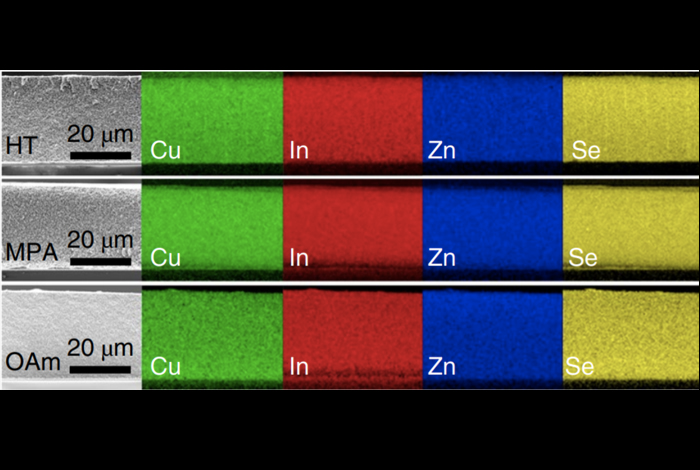May 19 2020
Researchers at Los Alamos National Laboratory have developed innovative quantum dot solar cells that match the efficiency of prevalent quantum-dot based devices, without using lead or other toxic elements on which a majority of solar cells of this kind depend.
 Scanning electron microscope image of electrodes infiltrated with quantum dots (left) and the corresponding distributions of copper, indium, zinc, and selenium across the film thickness. Image Credit: Los Alamos National Laboratory.
Scanning electron microscope image of electrodes infiltrated with quantum dots (left) and the corresponding distributions of copper, indium, zinc, and selenium across the film thickness. Image Credit: Los Alamos National Laboratory.
This quantum-dot approach shows great promise for a new type of toxic-element-free, inexpensive solar cells that exhibit remarkable defect tolerance.
Victor Klimov, Physicist, Los Alamos National Laboratory
Klimov, who specializes in semiconductor nanocrystals, is the lead author of the study featured on the cover of the Nature Energy journal.
Apart from demonstrating highly efficient devices, the researchers also unraveled the mechanism that underlies their superior defect tolerance. The defect states in copper indium selenide quantum dots do not affect the photovoltaic performance but promote the photoconversion process.
Already, quantum dots have found various applications, with many more to come. Specifically, they are highly efficient light emitters. They are different from light-emitting materials of other types. This is because their color is not fixed and can be easily adjusted by modifying the size of the quantum dot.
This characteristic has been used in televisions and displays, and it would not be very long before they can be used to develop more efficient, color-tunable light bulbs.
For several decades, researchers have been intrigued by the versatile physics of nanosized semiconductor crystals developed through colloidal synthesis. Thanks to their very small sizes—ranging a few nanometers across—it is possible to control the properties of the nanocrystals at the most basic quantum-mechanical level. Thus, they are named “quantum dots.”
The quantum dots’ size-adjustable properties can also enable efficient harnessing of sunlight, which is highly beneficial in solar-energy conversion. The efficiencies of advanced quantum dot solar cells have been quickly nearing those of conventional thin-film photovoltaics. But in a majority of the cases, they include highly toxic heavy metals like cadmium and lead, which restricts their practical utility.
Researchers at the Los Alamos National Laboratory characterized new and highly efficient quantum dot solar cells that did not use any toxic elements. They used a reaction of selenium, copper, and indium, together with zinc to develop zinc-doped quantum dots. The dots were added to voids of an extremely porous titania film that acted as a charge collecting electrode.
The quantum dots absorbed the incident solar photons, which led to the emission of tightly bound electrons into a highly mobile conduction band. Then, these electrons were transferred to the titania electrode, thus eventually producing a photocurrent.
We were pleasantly surprised by the results of the measurements of our devices. Due to their very complex composition (four elements are combined in the same nanosized particle), these dots are prone to defects.
Victor Klimov, Physicist, Los Alamos National Laboratory
Klimov continued, “Despite these imperfections, they showed nearly perfect performance in our solar cells—per each 100 absorbed photons we detected 85 photogenerated electrons, implying that the photon-to-electron conversion efficiency was 85 percent.”
In combination with the superior defect tolerance and toxic-element-free composition, the high photoconversion efficiencies render these quantum dots highly potential materials for developing readily scalable, affordable, and potentially disposable solar cells.
Journal Reference:
Du, J., et al. (2020) Spectroscopic insights into high defect tolerance of Zn:CuInSe2 quantum-dot-sensitized solar cells. Nature Energy. doi.org/10.1038/s41560-020-0617-6.